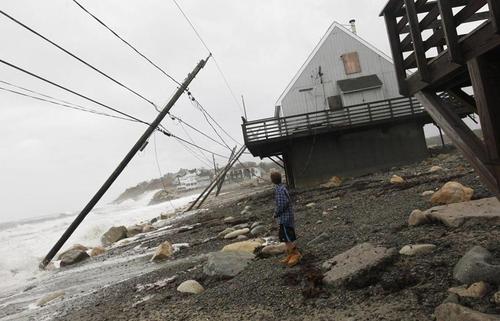By Doug Struck
Globe Correspondent
The changing climate in New England brings the risk of more power failures as hotter weather will stress aging power plants, heat up their cooling water, and add higher demands to the power system, according to the Department of Energy.
“It’s not a perfect system now, and climate change will exacerbate the vulnerabilities,” said Jonathan Pershing, who oversaw a recent report by the department looking at the risks to the nation’s power supply from our rapidly changing environment.
The report detailed threats to other U.S. regions that New England will largely escape: severe drought, shrinking water supply for crops, disappearing river flows. But New England can brace for more severe storms, longer hot weather, and rising sea levels, the report notes.
The Northeast has seen a higher rate of air temperature change since 1901– an average rate of 2 to 4 degrees per century– than any region in the United States except the extreme Southwest and Alaska.
 That warmer air puts New England in the bull’s eye of severe storms. For every rise of 1.8 degrees Fahrenheit, the air can hold about 7 percent more humidity. That water eventually drops in harder deluges. Since 1958, the amount of precipitation falling in very heavy events has increased 67 percent in the Northeast, far more than in any other region, according to the report.
That warmer air puts New England in the bull’s eye of severe storms. For every rise of 1.8 degrees Fahrenheit, the air can hold about 7 percent more humidity. That water eventually drops in harder deluges. Since 1958, the amount of precipitation falling in very heavy events has increased 67 percent in the Northeast, far more than in any other region, according to the report.
That means more downpours, more flooding and more heavy winter storms. Hurricane Irene two years ago deluged the East Coast and caused massive power outages, Hurricane Sandy left millions without power in 17 states in October, and a blizzard in February buried New England and brought down power lines.
In addition, the storms can combine with sea level rise to bring “perfect storm” events, such as Hurricane Sandy’s marriage to high tides that devastated parts of coastal New York and New Jersey, and would have caused massive flooding in Boston had it hit five hours earlier at high tide.
“Most regions have something to worry about. In New England, the main concerns are with things like storms and the effects of temperature changes on ways of life, patterns of life,” said Thomas Wilbanks, a fellow at the Oak Ridge National Laboratory in Tennessee and one of the principal authors of the report.
As Boston’s weather becomes more like that of Philadelphia or Washington, the power systems of the aging infrastructure of the region will be tested, Pershing said in a telephone interview.
“I was in Cape Cod last week, and I was struck by the number of people installing air conditioners,” he said. “When I was there as a youth, you had a few hot days, and that was it.”
The electrical grid is hit by a triple threat: hotter weather sends demand soaring, but also saps the efficiency of transmission lines and cuts into generating capacity, the report noted.
Power plants that depend on water for cooling along the Connecticut River may see their supplies drop, and plants may have to shut down if intake water is too warm. Power plants along the coast may be vulnerable to flooding. And all may be asked to operate flat-out in hotter weather.
“Systems just work harder, not just for a day but for a week,” he said. “At that point things that are a little old and a little stressed don’t work properly.”
The report is among the growing efforts to look at the prospects for calamity in our society as changes from a warming climate become inevitable. “It’s more about managing risks,” said Pershing, who is deputy assistant deputy for climate change policy. “It’s less about avoiding the problem than about rapid recovery—prepositioning the fuel, where the pumps are, what kinds of emergency communications there are.”
“Things are changing,” Wilbanks said. “We may still have arguments about the policy, but the impacts are real and they have to be figured into the economic equations.”
In many cases, Wilbanks said, the strategies must be tailored to the individual circumstances of cities and towns.
“It’ s hard to do ‘one size fits all,’” he said. “This should not be seen as federal government problem, but a national problem. There are things the federal government can do. But in many cases the impacts and the adaptations are very localized.”
